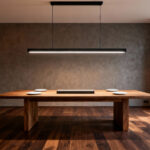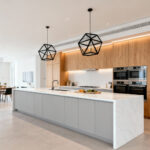Your living room is where life happens. It’s your sanctuary for unwinding, your social hub for gatherings, and—for many of us now—our full-time or part-time office. As a workspace designer, I’ve spent years helping people optimize their corporate and home offices, and the biggest challenge I see today is the blurring of these lines. The living room has to do it all.
But here’s the thing: making your living room a more productive, comfortable space doesn’t mean you have to buy a grey cubicle and plop it in the corner. Honestly, it’s the opposite. The best hybrid living spaces feel cohesive, intentional, and personal. They support your professional success and your personal comfort, often with the same design choices.
Ready to get your space working better for you? Let’s walk through 19 ideas that will help you refresh your living room, making it a place that works hard and lets you rest easy.
1. Find Your Anchor: Establish a Focal Point
Every room needs a visual anchor—something your eye naturally lands on. Without it, a room can feel chaotic, especially when it’s filled with the day’s clutter from both work and life. A focal point isn’t just some fancy design term; it’s a psychological tool that brings a sense of order and calm to a space. It tells your brain where to look and what the room is primarily about.

Your room might already have one, like a fireplace, a large picture window, or some nice built-ins. If it doesn’t, you get to create it. A dramatic accent wall, a massive piece of art, or a really stunning media center can do the trick. The goal is to have one primary point that organizes the rest of the room. When you clock off for the day, your focus should shift from your laptop screen to that beautiful, relaxing view or a crackling fire. It’s a non-verbal cue that the workday is over.
Once you have this anchor, every other decision—from where the sofa goes to where you place a lamp—becomes infinitely easier. You’re no longer just filling a room; you’re arranging it around a central, calming theme.
2. Breathe a Little: Introduce Indoor Plants
Staring at a screen for eight hours a day can feel draining and sterile. One of the quickest ways to combat that is by bringing a bit of the outside world in. Plants do more than just sit there and look pretty; they introduce life, color, and organic texture into a space dominated by hard surfaces and electronics. I’ve seen the mood of a room (and its occupant) shift dramatically with the addition of just one or two well-chosen plants.

Choosing the right plant comes down to being honest about your space and your lifestyle. Take a look at your light. Do you get bright, direct sun, or is your corner a bit shadowy?
- Low light survivors: Snake plants, ZZ plants, and pothos are famously hard to kill.
- Bright, but not direct sun: A fiddle leaf fig, bird of paradise, or a classic rubber plant will thrive.
A client of mine felt her city apartment was just “too much glass and steel.” We grouped a tall Bird of Paradise, a medium-sized Monstera, and a trailing pothos in a corner. It instantly softened the entire room and gave her a living, breathing backdrop for video calls that felt authentic, not staged.
3. Tell Your Story: Create a Gallery Wall
A gallery wall is more than a collection of pictures; it’s a visual mood board for your life. In an age where our professional and personal identities can get muddled, a wall that screams you is a powerful anchor. It’s a chance to display the things that make you who you are, outside of your job title: photos from a memorable trip, art from a local fair, a framed menu from a special anniversary dinner.

The best gallery walls have variety. Don’t just stick to identical frames. Mix it up:
- Photos and abstract art prints
- Mirrors with interesting shapes
- Small shelves holding a meaningful object or two
- Maybe even a framed piece of fabric or a cool vintage postcard.
What’s the secret to making it look curated, not chaotic? Lay everything out on the floor first. Play with the arrangement, starting with the largest piece in the center and working your way out. Use painter’s tape to mark the spots on the wall before you even pick up a hammer. This way, you avoid “nail hole regret” and create a focal point that tells a story only you can tell.
4. Open It Up: Use Mirrors to Enhance Light and Space
I’ve lost count of the number of home office setups I’ve seen crammed into a dark corner. One of the most effective tricks to fight this is a well-placed mirror. Mirrors are basically magic for small or poorly lit spaces. They create the illusion of depth and, more importantly, they bounce light around the room, making everything feel brighter and more open.

The trick is strategic placement. Hang a large mirror directly across from a window, and you’ve essentially doubled your natural light. This is a game-changer for video calls, as it provides a natural “fill light” that makes you look better on camera without any fancy equipment. In a long, narrow room, placing a mirror on the longer wall can make the space feel wider and more balanced.
Just be mindful of what your mirror reflects. You want it to reflect a window, a beautiful piece of art, or an open doorway—not the pile of laundry in the corner or the tangle of cords under your desk. It’s a simple change that can fundamentally alter the energy and perception of your room.
5. Make a Statement (But Make it Comfortable)
Every living room can benefit from one piece of furniture that has real personality—a velvet sofa in a rich jewel tone, a uniquely shaped armchair, or a live-edge wood coffee table. This “statement piece” anchors your design and gives the room an immediate dose of character. It’s the piece that makes guests say, “Wow, where did you get that?”

But here’s my workspace-designer take on it: your statement piece has to be functional and, above all, comfortable. For so many of us, the sofa isn’t just for watching movies anymore. It’s where we decompress after a long day of meetings, where we might answer a few last emails, or where we brainstorm big ideas. If that stunning, architectural chair is miserable to sit in for more than ten minutes, it’s failed its primary job.
Think of it as an investment in your well-being. That piece should not only be a visual anchor but a comfortable, supportive part of your daily routine. Before you buy, check the dimensions—use tape to map it out on your floor—and if you can, always, always sit in it first.
6. Hide the Mess: Smart and Stylish Storage
Work-from-home life creates “stuff.” Laptops, notebooks, chargers, headsets… by the end of the day, this work-related clutter can easily take over your relaxation space, making it impossible to truly switch off. This is where stylish storage becomes your best friend. The goal isn’t just to hide things; it’s to create a system that enhances your room’s aesthetic while keeping it organized.

Look for pieces that do double duty:
- A media console with deep drawers for your tech accessories.
- An upholstered ottoman that opens up to hide blankets, your laptop, and notebooks.
- decorative baskets are perfect for corralling smaller items and can be tucked under a console table.
- Vintage trunks add character and are amazing for storing things you don’t need every day.
The most important thing is to create an “end-of-day shutdown ritual.” Having a designated, beautiful place to put your work things away signals to your brain that the professional part of the day is over. It’s a small act that creates a massive mental boundary.
7. Create Your Zones
In an open-plan home, your living room might also be your dining room and your office. Without clear visual cues, these areas can bleed into one another, making the whole space feel messy and undefined. The solution is to create “zones” that give each area its own distinct purpose, even without walls.

Area rugs are the easiest way to do this. A large rug can anchor your main seating area, clearly defining the “living room” from the surrounding space. You can also use furniture placement. For instance, floating your sofa in the middle of the room with a console table behind it creates a natural divider between the conversation area and, say, a small work nook behind it.
Think about creating psychological boundaries. A reading chair and a dedicated lamp in a corner form a “reading zone.” A small desk against a wall with its own task light becomes a “work zone.” This helps you mentally shift gears as you move through the space. You’re not just in one giant, chaotic room; you’re in the relaxation zone or the focus zone, which makes it much easier to be present in whatever you’re doing.
8. Get Personal with Photos and Mementos
I can’t stress this enough: your home should look like you live there. Even the most perfectly designed room can feel cold and impersonal if it lacks those little touches that tell your story. Photos, travel souvenirs, inherited pieces—these are the things that turn a house into a home.

From a well-being perspective, surrounding yourself with meaningful objects is incredibly powerful. During a stressful workday, glancing over at a photo from a favorite vacation or a small object you picked up on an adventure can be a fantastic micro-break, grounding you in positive memories.
The key is curation. Instead of scattering things everywhere, group them together. Create a small vignette on a bookshelf with a few photos, a treasured book, and a small plant. Or use a shadow box to display small mementos that would otherwise get lost. It’s not about clutter; it’s about a thoughtfully displayed collection of things that make you happy.
9. Layer in a Mix of Textures
Color gets all the attention, but texture is what gives a room soul. A room with only smooth, flat surfaces—think leather sofa, glass table, metal lamps—can feel cold and uninviting. By layering in different textures, you create depth, warmth, and tactile interest.

Think about how things feel. Contrast the smooth leather of a chair with a chunky, knit wool throw. Place a rough-hewn wooden bowl on a sleek, polished console table. Mix a velvet pillow with a linen one on your sofa. Incorporate natural fibers like jute in a rug or rattan in a basket. These contrasts are what make a space feel rich and layered.
After a day spent typing on a smooth keyboard and staring at a glass screen, engaging your sense of touch can be incredibly grounding. It’s a sensory way to disconnect from the digital world and reconnect with your physical environment, making your living room a true refuge.
10. Master Your Windows
Window treatments are so much more than just decoration; they are functional powerhouses. They control light, provide privacy, can improve your home’s energy efficiency, and add a major dose of style. For anyone working from home, getting your window treatments right is crucial.

The wrong choice can mean battling terrible screen glare at certain times of the day. The solution I recommend most often is layering. For example, combine sheer, light-filtering shades with thicker, blackout curtains. The sheers give you privacy and soft, diffused light during the day (perfect for working), while the curtains can be drawn for movie nights or to completely block out light for focused work.
A pro tip for making your room feel bigger: hang your curtain rod high and wide. Mount it several inches above the window frame and extend it 6-12 inches on either side. This tricks the eye into thinking the window (and the ceiling) is bigger and more grand than it actually is.
11. Find Soul with Vintage and Antique Pieces
There’s a certain character and history in vintage or antique pieces that you just can’t get from mass-produced furniture. A mid-century modern credenza, a slightly worn leather armchair, or a set of old botanical prints adds a layer of soul and story to a room that makes it feel curated over time, not bought in a day.

Mixing old with new is what keeps a room from looking like a dusty museum. Pair that vintage credenza with your sleek, modern TV. Place an ornate, antique mirror over a clean-lined contemporary console table. This blend is what creates a truly personal and interesting style.
And frankly, it’s a more sustainable way to decorate. By giving an old piece a new life, you’re reducing waste and often getting higher-quality craftsmanship for your money. Start small—a vintage lamp or a collection of old glass bottles—and see how it instantly adds a layer of authenticity to your space.
12. Sweat the Small Stuff: Upgrade Your Hardware
Want a high-impact update with minimal effort and cost? Swap out your hardware. I’m talking about cabinet pulls, doorknobs, light switch plates, and curtain rods. These are the little details that can make a room feel either cheap and builder-grade or polished and intentional.

Think of it as the jewelry of your room. Replacing basic, boring cabinet pulls on a media unit with something more substantial and stylish—like brushed brass or matte black—can completely transform the piece. Swapping out a flimsy, standard curtain rod for a thicker one with nice finials adds a touch of custom-looking polish.
This is a fantastic weekend project for anyone feeling a bit overwhelmed by the idea of a full redecoration. It provides a quick win and a sense of control over your environment, which can be a huge morale booster when your home is also your office. Just be sure to measure the distance between screw holes on existing pulls before you buy new ones to make it a simple swap.
13. Get the Scale and Proportion Right
Have you ever walked into a room that just felt… off? Chances are, it was an issue of scale and proportion. Scale is about how the size of your furniture relates to the size of your room and the other pieces in it. A massive, overstuffed sofa can swallow a small room, while a tiny loveseat might feel lost and adrift in a large, open space.

It’s about visual weight, too. A glass coffee table with thin legs has a much lighter visual weight than a solid wood trunk of the same dimensions. Getting this balance right is what makes a room feel harmonious and calm, not jarring or chaotic. This reduces the “cognitive load” of a space, which is a fancy way of saying it makes it easier and more pleasant to be in—something we all need more of during the workday.
Before you buy a major piece of furniture, use painter’s tape to mark out its dimensions on the floor. See how it feels, how you’d walk around it. This simple step can save you from a very large, very expensive mistake.
14. Add a Twist with a Sculptural Accent
Our living rooms are often filled with squares and rectangles—the TV, the coffee table, the windows, the sofa. Introducing something with an interesting, three-dimensional shape can break up that monotony and add a touch of artistic flair. A sculptural accent piece is something that exists purely to be beautiful or interesting to look at.

This could be a large, abstract metal sculpture on the floor, a collection of unique ceramic vases on a shelf, or a piece of large-scale, textural wall art. It gives your eye a place to land when you look away from your computer screen, something more interesting to focus on than a blank wall.
It doesn’t have to be a major investment. A unique floor lamp with an architectural shape, a large, gnarled piece of driftwood on your mantel, or a mobile hanging in a corner can all serve the same purpose. It’s about introducing form and artistry that makes the space feel more sophisticated and intentional.
15. Don’t Forget to Look Up: The Fifth Wall
The ceiling is the most neglected surface in decorating. We agonize over wall colors and rug choices, but the “fifth wall” above our heads is usually just a flat expanse of white. This is a huge missed opportunity to add character and dimension to your room.

For a dramatic, cozy effect, you could paint the ceiling a dark, moody color like charcoal or navy. This works especially well in rooms with high ceilings, creating a sense of intimacy. For a more subtle touch, you could add architectural detail like crown molding or even paint it a slightly lighter shade of your wall color for a soft, cohesive look.
In one client’s home, we wallpapered the ceiling of a small recessed nook where she had her reading chair. It instantly defined that corner as a special, cozy retreat, visually separating it from the rest of the open living area. It’s an unexpected move that can have a massive impact.
16. Layer Your Lighting for Mood and Function
Good lighting isn’t a single overhead fixture. Good lighting is a flexible system that can adapt to everything you do in your living room. As someone who designs workspaces, I know that the lighting you need for a focused task or a professional video call is completely different from the lighting you want for relaxing with a movie. That’s why you need layers.

Every well-lit room should have at least three types of lighting:
- Ambient: The general, overall light from ceiling fixtures or recessed cans.
- Task: Focused light for specific activities, like a reading lamp by a chair or under-cabinet lighting.
- Accent: Light that highlights something specific, like a spotlight on a piece of art or an uplight behind a plant.
Crucially, put as many of these lights on dimmers as possible. Dimmers are not a luxury; they are a necessity for a multi-functional space. They allow you to dial up bright, cool light for working and then transition to warm, low light to signal that it’s time to unwind.
17. Use Color to Set a Mood
Color is emotional. It can make us feel energized, calm, creative, or cozy. When you’re choosing a color palette for a room you both work and live in, think about the primary mood you want to create. Do you need a calm, focused environment, or a more vibrant, inspiring one?

Blues and greens are known for their calming, stress-reducing properties—perfect for a space where you need to decompress. Warmer colors like soft yellows or terracottas can feel energizing and optimistic. You don’t have to paint your entire room a bold color to get the effect. The classic 60-30-10 rule is a great guide: 60% of your room is a dominant, neutral color (like the walls), 30% is a secondary color (maybe an accent chair or your curtains), and 10% is an accent pop (throw pillows, art, accessories).
Always test your paint colors on the wall first. A color can look completely different depending on the light in your room. Live with the swatches for a few days and see how they look in the morning, afternoon, and evening before you commit.
18. Arrange for Conversation, Not Just for Television
This is one of the biggest mistakes I see people make. They push all their furniture up against the walls, facing a single focal point: the television. This might be great for watching TV, but it’s terrible for everything else. A living room should be arranged to encourage human connection.

Pull your furniture away from the walls and arrange it to facilitate conversation. Place sofas and chairs so they face each other, ideally no more than 8 feet apart, so people can talk without shouting. Make sure every seat has a small table or surface nearby to place a drink.
When your space is designed to bring people together, it becomes a physical invitation to log off your computer and connect with the people you live with. It makes the “living” part of the living room the priority again, which is a powerful way to reclaim your space from work.
19. Find the Sweet Spot: Balance Function and Personality
Ultimately, the best living room is one that strikes a perfect balance between how it needs to function and how you want it to feel. It needs to be practical for your day-to-day life—whether that includes conference calls, homework sessions, or family movie nights—but it also needs to be a sanctuary that reflects who you are.

This requires an honest look at your life. Don’t design a formal, all-white living room if you have two big dogs and a toddler. Don’t create a massive, sprawling entertainment center if you mostly read books. Your room should be a solution to the realities of your life, not a problem you have to constantly work around.
The goal isn’t to create a showroom that looks perfect in a magazine. It’s to create a space that supports you, comforts you, and makes you feel truly at home, no matter what you’re doing in it.
It’s Your Space, Make it Yours
Transforming your living room doesn’t have to happen all at once. Start with the idea that speaks to you most. Maybe this weekend you’ll tackle that gallery wall you’ve always wanted to hang, or perhaps you’ll start by simply buying one great plant.
These changes are more than just cosmetic. They’re investments in your well-being and productivity. By creating a living room that thoughtfully balances function with personality, you’re designing a space that makes it easier to be both your best professional self and your most relaxed personal self.






